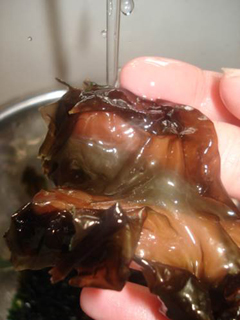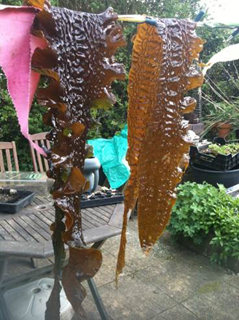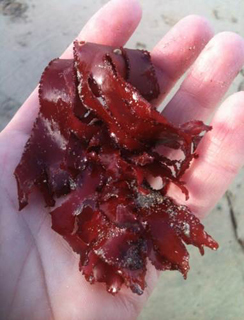
Well what a busy October! My scrummy little girl turned 1 (no idea where that time has gone!). I did my last Heligan forage for the year and will be back there next April. I had a hilarious, somewhat hectic session at Newquay Orchard with 90 7-8 year old kids teaching them foraging and I had a fab seaweed forage with many more to come, through the winter months.
My most recent major project was teaching a day masterclass in foraging at Warwick University. I included a foraged lunch so I made sea beet quiche, nettle and feta parcels, windfall apple and cinnamon tray bake, wild mushroom croquettes, hazelnut dukkah and a few other autumnal treats. It went really well and I even found the service tree (Sorbus torminalis) which was a first for me!
I’ve been making the most of apples, crab apples, the long season of blackberries and grabbing the last of the sea buckthorn berries before they go over.
So going back to seaweeds, have you ever tried any? Seaweeds are incredible – they are delicious, nutritious, medicinal, cosmetic… basically they tick all the boxes.

Seaweeds fit into 3 categories – brown, red or green seaweeds. They are fairly selective as to where they grow, for example channelled wrack likes to grow in the splash zone which is high up the beach whereas sugar kelp and oarweed grow in the subtidal zone so they are always submerged.
If you are just starting out, head for the green seaweeds first. If it looks like grass, then it is gutweed which is either Ulva intestinalis, Ulva linza or Ulva compressa – whichever it is, give it a rinse to get any sand out of it and try it raw or better still dried or pan fried. Sea lettuce is flat sheets of green. Try dressed seaweed salad or dry it to crumble on dishes including buttered popcorn.
Next take a look at brown seaweeds – these are wracks and kelps. There are many types of wrack which can be easily identified from their vesicles, eggs or bladders, or from their edges – for instance serrated wrack has a serrated edge, spiralled wrack gently spirals and grows quite high up the shoreline and bladderwrack has the double bladders.
Long strands with single bladders are knotted wracks and small channelled stipes are (you guessed it) channelled wrack. The kelps I mentioned earlier are oarweed and sugar kelp. These are both tough to cope with the battering waves. If you are unsure what they look like, if you have a dog, he will no doubt have played with the stipe of oarweed on the beach, working him or herself into a frenzy as they whip themselves with this new-found seaweedy stick!

Sugar kelp has a crinkly rippled effect down the length of it. So what do you ‘do’ with these brown seaweeds? Many of the wracks have a high iodine content so it’s best to dry and finely crumble into dishes as a seasoning. Channelled wrack works well as a side vegetable which can be prepared by simmering until tender and dabbing with a little butter, or added to a stir fry.
Serrated wrack is good for seaweed baths and by this I mean if you pop it in your bath, it helps condition your skin and hair, plus you will absorb any nutrients and minerals from the seaweed. Knotted wrack is an incredible seaweed which has the potential to help tackle certain cancers by making the cancer cells destroy themselves. When it comes to the kelps, they can be used dried and whole as a stock – in Japan they call it ‘kombu’. Both oarweed and sugar kelp can also be baked or deep fried to make delicious crisps, but be warned, when you are deep frying them they spit like fun!!
Two more brown seaweeds that must be mentioned are sea spaghetti (thongweed) and Japanese wireweed. Sea spaghetti is well named as you can cook it just like spaghetti and it absorbs the flavours it is combined with, be it savoury or sweet. Japanese wireweed is an invasive which is very tasty raw so by harvesting it, you are helping keep it under control!

Skipping on to red seaweeds, these are things like dulse, pepper dulse, nori and carragheen (otherwise known as Irish moss). Dulse is the most delicious, super versatile seaweed which can be cooked any which-way but one of the best has to be fried as it goes almost like bacon (vegetarian breakfasts have just got better!). Pepper dulse may be small but it packs a peppery punch.
Either eaten raw or dried, it has a buttery smoothness but almost a garlicky aftertaste. Nori, known as laver in Wales, can be simmered for hours to make laver bread or dried and added to dishes to give a delicious savoury flavour (or eaten as a snack). Carragheen is very useful for vegetarians as it can be used to set puddings or savoury jellies without the use of beef gelatine.
I had a lovely family come foraging with me a few years ago and the Dad was originally from Jamaica. I told him about carragheen and he said they would add it to a milkshake for putting ‘lead in your pencil’! It is actually used as a general pick-me-up so if you are feeling under the weather, then a cocktail of carragheen, condensed milk, nutmeg and other ingredients is the Jamaican cure all.
Cheats sea spaghetti and dulse carbonara (serves 2) (v)

Fresh or dried sea spaghetti – enough for 2 people
3-4 tbsp dried crumbled dulse
1 small tub crème fraiche
50 g grated parmesan
1 tbsp butter
1 garlic clove, peeled and finely chopped
Sea salt and black pepper
Put a saucepan of water on to boil, add the sea spaghetti and simmer until cooked (try a little piece after 10 minutes to see if it is tender enough, just as you would normal spaghetti). In a large frying pan add the butter and gently fry the garlic and dulse for a minute or 2. Add the spaghetti, parmesan and crème fraiche, stirring until coated and then season to taste.

